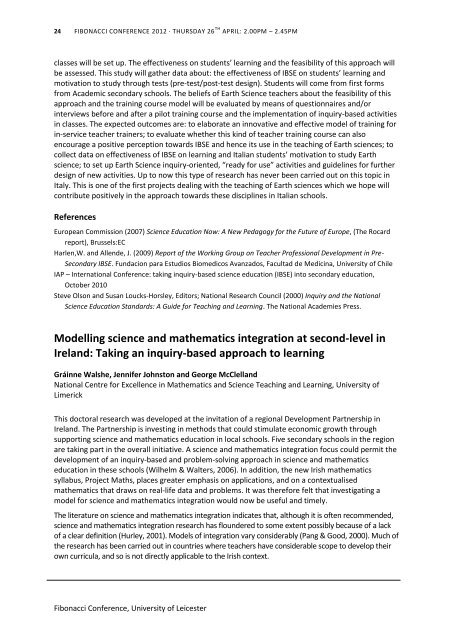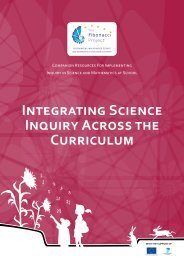disseminating inquiry-based science and ... - Fibonacci-Project
disseminating inquiry-based science and ... - Fibonacci-Project
disseminating inquiry-based science and ... - Fibonacci-Project
Create successful ePaper yourself
Turn your PDF publications into a flip-book with our unique Google optimized e-Paper software.
24 FIBONACCI CONFERENCE 2012 ∙ THURSDAY 26 TH APRIL: 2.00PM – 2.45PM<br />
classes will be set up. The effectiveness on students’ learning <strong>and</strong> the feasibility of this approach will<br />
be assessed. This study will gather data about: the effectiveness of IBSE on students’ learning <strong>and</strong><br />
motivation to study through tests (pre-test/post-test design). Students will come from first forms<br />
from Academic secondary schools. The beliefs of Earth Science teachers about the feasibility of this<br />
approach <strong>and</strong> the training course model will be evaluated by means of questionnaires <strong>and</strong>/or<br />
interviews before <strong>and</strong> after a pilot training course <strong>and</strong> the implementation of <strong>inquiry</strong>-<strong>based</strong> activities<br />
in classes. The expected outcomes are: to elaborate an innovative <strong>and</strong> effective model of training for<br />
in-service teacher trainers; to evaluate whether this kind of teacher training course can also<br />
encourage a positive perception towards IBSE <strong>and</strong> hence its use in the teaching of Earth <strong>science</strong>s; to<br />
collect data on effectiveness of IBSE on learning <strong>and</strong> Italian students’ motivation to study Earth<br />
<strong>science</strong>; to set up Earth Science <strong>inquiry</strong>-oriented, “ready for use” activities <strong>and</strong> guidelines for further<br />
design of new activities. Up to now this type of research has never been carried out on this topic in<br />
Italy. This is one of the first projects dealing with the teaching of Earth <strong>science</strong>s which we hope will<br />
contribute positively in the approach towards these disciplines in Italian schools.<br />
References<br />
European Commission (2007) Science Education Now: A New Pedagogy for the Future of Europe, (The Rocard<br />
report), Brussels:EC<br />
Harlen,W. <strong>and</strong> Allende, J. (2009) Report of the Working Group on Teacher Professional Development in Pre-<br />
Secondary IBSE. Fundacion para Estudios Biomedicos Avanzados, Facultad de Medicina, University of Chile<br />
IAP – International Conference: taking <strong>inquiry</strong>-<strong>based</strong> <strong>science</strong> education (IBSE) into secondary education,<br />
October 2010<br />
Steve Olson <strong>and</strong> Susan Loucks-Horsley, Editors; National Research Council (2000) Inquiry <strong>and</strong> the National<br />
Science Education St<strong>and</strong>ards: A Guide for Teaching <strong>and</strong> Learning. The National Academies Press.<br />
Modelling <strong>science</strong> <strong>and</strong> mathematics integration at second-level in<br />
Irel<strong>and</strong>: Taking an <strong>inquiry</strong>-<strong>based</strong> approach to learning<br />
Gráinne Walshe, Jennifer Johnston <strong>and</strong> George McClell<strong>and</strong><br />
National Centre for Excellence in Mathematics <strong>and</strong> Science Teaching <strong>and</strong> Learning, University of<br />
Limerick<br />
This doctoral research was developed at the invitation of a regional Development Partnership in<br />
Irel<strong>and</strong>. The Partnership is investing in methods that could stimulate economic growth through<br />
supporting <strong>science</strong> <strong>and</strong> mathematics education in local schools. Five secondary schools in the region<br />
are taking part in the overall initiative. A <strong>science</strong> <strong>and</strong> mathematics integration focus could permit the<br />
development of an <strong>inquiry</strong>-<strong>based</strong> <strong>and</strong> problem-solving approach in <strong>science</strong> <strong>and</strong> mathematics<br />
education in these schools (Wilhelm & Walters, 2006). In addition, the new Irish mathematics<br />
syllabus, <strong>Project</strong> Maths, places greater emphasis on applications, <strong>and</strong> on a contextualised<br />
mathematics that draws on real-life data <strong>and</strong> problems. It was therefore felt that investigating a<br />
model for <strong>science</strong> <strong>and</strong> mathematics integration would now be useful <strong>and</strong> timely.<br />
The literature on <strong>science</strong> <strong>and</strong> mathematics integration indicates that, although it is often recommended,<br />
<strong>science</strong> <strong>and</strong> mathematics integration research has floundered to some extent possibly because of a lack<br />
of a clear definition (Hurley, 2001). Models of integration vary considerably (Pang & Good, 2000). Much of<br />
the research has been carried out in countries where teachers have considerable scope to develop their<br />
own curricula, <strong>and</strong> so is not directly applicable to the Irish context.<br />
<strong>Fibonacci</strong> Conference, University of Leicester




